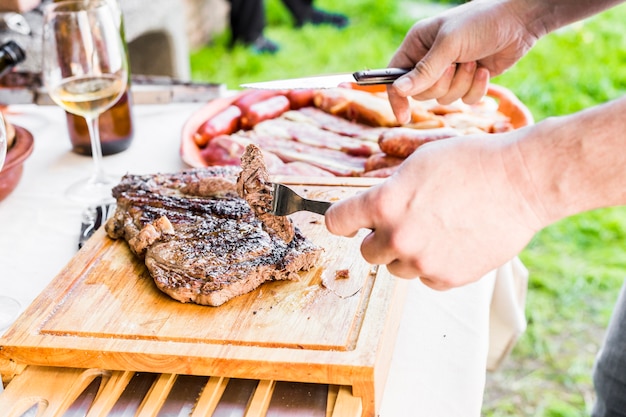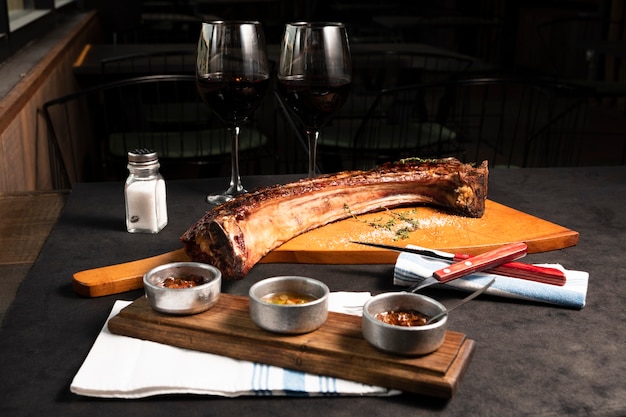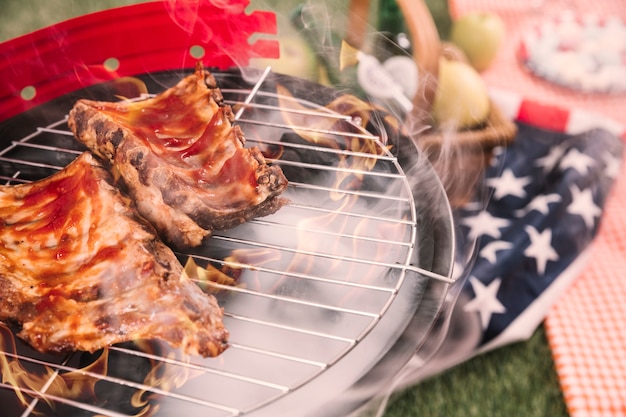Ah, brisket. Just the name conjures up images of smoky goodness and that melt-in-your-mouth tenderness. It's a true labour of love, a challenge that rewards you with the most incredible BBQ experience. For years, I've been obsessed with perfecting my brisket game, and I’ve learned that mastering the art of temperature control is the key to unlocking the magic.
This isn’t just a basic guide to brisket cooking temperatures. It's a journey through the science of meat, the intricacies of BBQ, and the sheer joy of a perfectly cooked brisket. So, grab a cuppa, settle in, and let’s delve into the world of brisket together.
(Part 1) The Anatomy of Brisket: Understanding the Beast

Before we even think about temperatures, we need to understand the beast we're dealing with. A brisket isn’t just a lump of meat; it’s a complex piece with distinct parts that behave differently when exposed to heat. Mastering the cook means understanding these nuances.
The Two Parts of Brisket: Point and Flat
A whole brisket is made up of two sections: the point and the flat. The point, often described as the "money muscle," is thicker and boasts more fat marbling. This fat translates to a rich flavour and inherently tender texture.
The flat, on the other hand, is leaner and possesses a more even texture. This leanness means it cooks faster and requires a slightly different approach to achieve that melt-in-your-mouth magic.
Think of them like two individuals on a long journey. The point, with its fat reserves, takes its time, basking in the low heat, allowing the fat to render down and the connective tissue to break down, creating that dreamy texture. The flat, being leaner, needs a bit more encouragement and a slightly higher temperature to achieve the same level of tenderness.
The Importance of Fat Marbling
Fat, my friends, is the hero of the brisket story. It’s the secret ingredient that transforms a tough piece of meat into a symphony of flavour and texture. The fat marbling throughout the brisket renders down during the cooking process, injecting moisture and flavour into every bite.
When you're choosing a brisket, it's not about a thick layer of fat on top; that won't do much for you. You want to see that marbling throughout the meat, guaranteeing that every part of the brisket benefits from that delicious fat rendering.
(Part 2) The Art of Temperature Control: Keeping it Steady

Now, let's talk temperature. This is where the magic happens. It’s not just about reaching a specific number on your thermometer; it’s about maintaining a steady, controlled heat throughout the cooking process. Think of it like baking a cake – you wouldn’t just throw it in a hot oven and forget about it, would you? The same principle applies to brisket.
The Magic of Low and Slow
Low and slow, that’s the mantra for brisket. The goal is to cook at a temperature between 225°F and 275°F (107°C - 135°C). It’s a marathon, not a sprint.
We all crave those shortcuts, but cranking up the heat is a recipe for disaster. High heat will dry out the meat before the fat has a chance to render, leaving you with a tough, flavourless brisket. Patience, my dear friends, is key.
The Importance of Even Heat
Maintaining a consistent temperature is crucial. Imagine a brisket where one part is cooked perfectly tender and juicy, while another is dry and tough – not a pretty sight. Fluctuations in heat can lead to uneven cooking, and nobody wants that.
This is where your smoker or grill comes in. A good smoker or grill with precise temperature control is your best friend. It’ll help you maintain a steady heat throughout the entire cooking process, ensuring an even, delicious result.
(Part 3) The Temperature Journey: From Smoke to Rest

Now, let's get into the heart of the matter (pun definitely intended!). The transformation of a brisket, from the first wisps of smoke to its final resting stage, is a beautiful thing. It's a journey we need to understand, and temperature is our guide.
The Smoke: Building Flavor
The first stage is smoking, where the brisket is bathed in low heat for several hours. This is where the real magic happens. The smoke gently permeates the meat, adding depth and complexity to the flavour, creating a masterpiece you’ll never forget.
The ideal temperature for this stage is between 225°F and 250°F (107°C - 121°C), though personal preference can dictate your choice. A lower temperature will create a more intense smoke ring, which is that beautiful dark band around the meat. A higher temperature will cook the brisket faster, but you may sacrifice the intensity of the smoke ring.
The Stall: The Great Plateau
As the brisket cooks, you'll inevitably hit a plateau – the infamous "stall." This is where the internal temperature seems to stubbornly refuse to rise any further. It’s a bit of a mystery, but it’s caused by the moisture in the meat turning to steam, creating a barrier that prevents the temperature from climbing higher.
Don't panic! The stall is a natural part of the brisket cooking process, and it's actually a good thing. It allows the collagen to break down, making the meat incredibly tender.
To navigate the stall, we need a few tricks up our sleeve. You can wrap the brisket in foil or butcher paper to trap in moisture and heat. Adding a little water to the smoker can also create steam, helping to break through the stall. This can last anywhere from a few hours to several hours, depending on the size of the brisket and your smoker.
The Bark: A Crispy, Flavourful Crust
As the brisket cooks, a beautiful thing happens: the surface starts to develop a crispy crust, known as the bark. This magical crust is the result of the sugars and proteins on the surface of the brisket caramelizing, creating an irresistible texture and an explosion of flavour.
To achieve that perfect bark, keep the temperature between 250°F and 275°F (121°C - 135°C) during the last few hours of cooking. This allows the bark to develop without burning, giving you that gorgeous crispy exterior.
The Rest: Let it Relax
Once the brisket reaches an internal temperature of around 195°F (90°C) for the flat and 203°F (95°C) for the point, it's time to take it off the heat. But, don't be tempted to slice it just yet. The brisket needs to rest, allowing the juices to redistribute throughout the meat and the muscle fibers to relax.
Wrap the brisket in foil or butcher paper and let it rest for at least an hour, ideally two. This crucial resting period results in a tender, juicy brisket that will melt in your mouth.
(Part 4) Reading the Signs: When is it Done?
The moment of truth! How do you know when your brisket is ready to be devoured? There’s no single answer, but there are several telltale signs to help you determine if your brisket is ready.
The Temperature Test: A Reliable Guide
The most reliable way to tell if a brisket is done is with a trusty meat thermometer. The flat should reach an internal temperature of 195°F (90°C), while the point should reach 203°F (95°C).
The Probe Test: A Test of Tenderness
Another good indicator is the probe test. Insert your meat thermometer into the thickest part of the brisket. If it slides in easily, with minimal resistance, then your brisket is done.
The Appearance Test: Clues from the Surface
The brisket should have a beautiful, mahogany brown bark and the fat should be rendered down. You should also see a little bit of juice on the surface, which is a good sign of a moist and juicy brisket.
(Part 5) The Tricky Part: Dealing with Stall
The stall, as we've discussed, is a natural part of the brisket cooking process, but it can be frustrating. It's like a hurdle in a race, something we need to overcome to reach the finish line.
Understanding the Stall
As the brisket cooks, the internal moisture turns to steam, creating a barrier that prevents the temperature from rising. This is the stall. It's a moment of tension, where we feel like we're stuck in limbo.
Strategies for Breaking the Stall
The best way to overcome the stall is to trap in heat and moisture. Think of it like a warm hug for your brisket. Here are a few tried-and-true methods:
- Wrap it Up: Wrap the brisket in foil or butcher paper. This creates a steamy environment, helping the temperature to rise and ensuring the meat stays moist.
- Add Some Water: Add a little bit of water to the smoker pan or drip pan. This creates steam, helping to break the stall and keep the meat juicy.
- Turn Down the Heat: If you’re using a smoker, you can turn the heat down slightly during the stall. This helps prevent the brisket from drying out, especially if the stall persists for a long time.
- Be Patient: The stall can last anywhere from a few hours to several hours. Just be patient and let the brisket do its thing. Resist the urge to rush the process, and you'll be rewarded with a tender and flavorful brisket.
(Part 6) Beyond the Basics: Mastering the Temperature Variations
Now let's delve deeper into the specific temperature ranges for different brisket cooking methods and styles.
Smoker Temperatures: A Guide for Different Woods
Smoking a brisket is the traditional and beloved way to cook it, and the temperature will depend on your chosen wood, each imparting a unique flavour profile. Here’s a rough guide:
| Wood Type | Recommended Temperature |
|---|---|
| Hickory | 225°F - 250°F (107°C - 121°C) |
| Mesquite | 225°F - 250°F (107°C - 121°C) |
| Oak | 225°F - 250°F (107°C - 121°C) |
| Pecan | 225°F - 250°F (107°C - 121°C) |
| Apple | 225°F - 250°F (107°C - 121°C) |
| Cherry | 225°F - 250°F (107°C - 121°C) |
Remember, these are just starting points. Feel free to experiment with different woods and temperatures to find what works best for your palate.
Oven Temperatures: A Quick and Convenient Option
You can also cook brisket in the oven, which is a more convenient option, especially for those who don't have a smoker or grill. The ideal oven temperature for brisket is 275°F (135°C).
reverse sear: A Modern Approach
The reverse sear is a popular technique that involves cooking the brisket at a low temperature for a longer period, then searing it at a high temperature to create a crispy bark. This method yields a beautifully tender interior and a perfectly crisp exterior.
For the low and slow stage, the temperature is usually between 225°F and 250°F (107°C - 121°C). For the sear, you'll need a hot grill or skillet, aiming for 500°F (260°C) or higher. This rapid high-heat sear creates that beautiful, caramelized bark.
(Part 7) The Final Touch: Finishing with a Bang
We're nearly there, folks! After all that careful attention and dedicated cooking, it's time to add the finishing touches that transform your brisket from good to truly exceptional.
The Art of Slicing: Thin, Even Pieces
Once the brisket has rested, it's time to slice it. Thin, even slices will ensure that the meat is tender and juicy, allowing the flavour to shine through in every bite.
A sharp carving knife will make slicing a breeze. If you're not confident with a carving knife, a good quality chef's knife will also work. The key is to slice against the grain of the meat, creating those beautiful, melt-in-your-mouth slices.
Sauce It Up: A Burst of Flavor
A good bbq sauce can really elevate your brisket, adding that final touch of flavour. Apply it to the slices or drizzle it over the whole brisket before serving.
There are countless BBQ sauces to choose from, each with its own unique combination of ingredients and flavour profiles. Experiment and find your favourite, adding a burst of flavour to your culinary masterpiece.
(Part 8) Brisket Mistakes: Avoiding Common Pitfalls
Everyone makes mistakes, but learning from those mistakes is part of the journey. Here are some common brisket blunders to avoid, so you can save yourself some heartache and frustration.
High Heat: The Enemy of Tenderness
We've said it before, and we'll say it again: cooking brisket at too high a temperature will result in dry, tough meat. Remember, low and slow is the key! The fat needs time to render, and the connective tissue needs time to break down.
Undercooked Brisket: A Safety Hazard
It's essential to cook brisket to an internal temperature of 195°F (90°C) for the flat and 203°F (95°C) for the point. This ensures the meat is safe to eat and destroys any harmful bacteria.
No Rest: A Recipe for Toughness
Allowing the brisket to rest after cooking is a crucial step in achieving tenderness. The resting time allows the juices to redistribute, resulting in a more succulent brisket.
Over-Trimming: Losing Precious Flavor
Don't be too aggressive with the trimming. The fat marbling is essential for flavour and tenderness. Just trim away any excess fat, but don't go overboard.
Not Using a Thermometer: Guesswork is Dangerous
A meat thermometer is essential for accurate temperature readings. Don't rely on visual cues, as they can be misleading. A thermometer will ensure your brisket is cooked to the perfect internal temperature, guaranteeing safety and deliciousness.
FAQs: Your Brisket Questions Answered
Now, let’s tackle some common questions you might have about brisket and temperatures:
1. What if my brisket is a bit dry?
There are a few things you can do. Adding a little bit of BBQ sauce to the slices will add moisture and flavour. You can also try adding a little bit of water to the smoker or drip pan. This will create steam, which can help to moisten the meat, giving it back that juicy texture.
2. What temperature should I use for a reverse sear?
For the low and slow stage, aim for 225°F to 250°F (107°C - 121°C). For the sear, you'll want to use a hot grill or skillet, aiming for 500°F (260°C) or higher. This rapid high-heat sear creates that beautiful, caramelized bark.
3. How long should I cook a brisket?
The cooking time for a brisket will vary depending on the size and thickness of the brisket. A small brisket (4-5 pounds) will take about 8-10 hours, while a large brisket (8-10 pounds) will take 12-14 hours or more.
4. Can I cook a brisket on a gas grill?
Yes, you can cook a brisket on a gas grill. Just make sure to set up your grill for indirect cooking. This means that the heat source should be on one side of the grill, while the brisket is on the other side. You can also use a smoker box to add smoke flavour, giving your brisket that authentic BBQ touch.
5. Can I use a meat thermometer for other cuts of meat?
Absolutely! A meat thermometer is a valuable tool for any meat cook. It can help you ensure that your meat is cooked to the correct temperature, regardless of the cut. From chicken to pork, a meat thermometer is your reliable guide to perfectly cooked meat every time.
Well, there you have it, folks. My brisket bible, a comprehensive guide to mastering the art of temperature control. Remember, practice makes perfect, and don’t be afraid to experiment. With a little patience and these tips, you'll be serving up mouthwatering brisket in no time.
Everyone is watching

Corn on the Cob: The Ultimate Guide to Perfectly Cooked Ears
Healthy MealsAh, corn on the cob. Just the name evokes images of sunny days, barbecues, and that sweet, juicy flavour that ...

Perfect Pork Roast Oven Cooking Time: A Guide to Delicious Results
Healthy MealsThere's something truly satisfying about a perfectly roasted pork. The aroma alone is enough to make your mout...

Ham Cooking Time: How Long to Bake, Smoke, or Boil a Delicious Ham
Healthy MealsAh, ham. It's a classic, isn't it? A real crowd-pleaser, especially around holidays. And when done right, it'...

Scallops: The Ultimate Guide to Perfect Cooking
Healthy MealsAh, scallops. Those delicate, sweet, and utterly delicious morsels of the sea. They hold a special place in my...

Spaghetti Squash: The Ultimate Guide to Cooking and Serving
Healthy MealsRemember that time you saw spaghetti squash at the supermarket, looking all bumpy and strange, and thought, "W...
